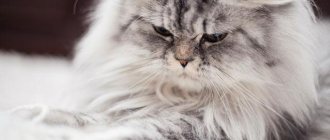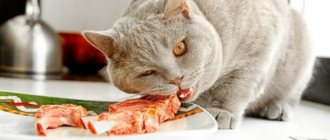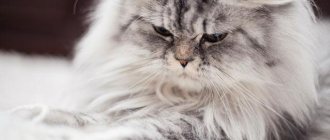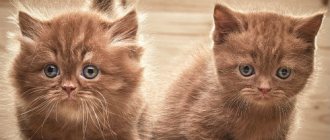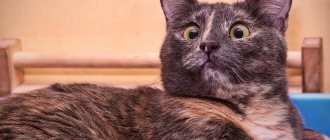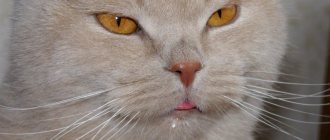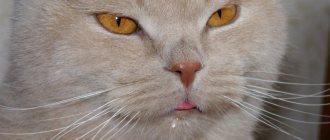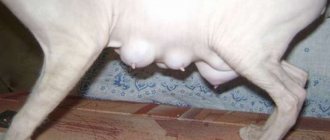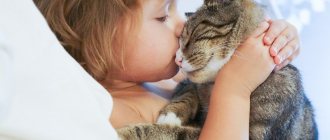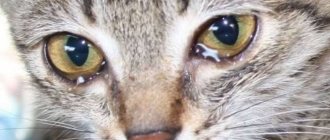Usually, owners are very attentive to the health of their furry pets. Therefore, they immediately notice even a slight squint in the gaze of their beloved cat. Scientists after studying called this phenomenon strabismus. It often appears in small kittens due to their weak and fragile eye muscles. In adult animals it can occur as a result of previous diseases. However, there is a breed of cross-eyed cat in which cross-eyedness is a representative feature.
Strabismus occurs in a number of animals of all breeds. But most of all the Thai and Siamese, as well as those descended from them:
- Javanese;
- Balinese;
- snow show.
The deviation is due to the genetic characteristics of the animals, identified by felinologists as an external sign. The breed of cross-eyed cats has the gene for acromelanism. It gives the animal’s fur coat an original color-point color and gives the eyes a sky-blue tint. Thanks to him, the legs and tail are painted in darker colors than the body. In addition to unique external beauty, the presence of the gene also leads to disturbances in the development of the optic nerve. As a result, objects appear flat to the cat, and even in a forked form. The animal’s efforts to bring the picture back to normal are what causes the change in eye position.
Does it happen to cats?
Strabismus, or strabismus, can be diagnosed in cats at any age. The pathological process develops as a result of disruption of the eye muscles or nerve fibers. Strabismus can be a genetic feature, that is, it can be transmitted hereditarily. Siamese and Oriental breeds are considered prone to the disease.
Strabismus occurs:
- unilateral (one eye is deviated from the normal position);
- bilateral (there is a deviation from the visual axis of both eyes).
Depending on which eye is looking where, the following types of strabismus are distinguished:
- Esotropia, or convergent strabismus. Occurs most often. It manifests itself as a shift of the pupils towards the nose.
- Exotropia, or divergent strabismus. Characterized by dilation of the pupils towards the temples.
Strabismus, regardless of its type, is considered a deviation from the norm.
In Siamese, Thai and other breeds
There are no breeds in which all representatives have strabismus. Strabismus can be diagnosed in any cat. But there are breeds in which this pathology is diagnosed more often than others:
- Thai;
- Siamese;
- Javanese;
- oriental;
- Balinese;
- snowshoe.
Scientists believe that strabismus in animals occurs due to acromelanism, a manifestation of the gene that is responsible for coat color and eye color. But acromelanism can also disrupt the process of proper development of the optic nerve, which is why strabismus appears.
The pathological process of the organs of vision is not always treatable.
In kittens at an early age
At an early age, strabismus is often observed in kittens. This feature does not always indicate a physiological deviation.
Pupils looking in different directions may be evidence that the eye muscles have not yet had time to strengthen. This type of strabismus does not require treatment. In most cases, by 5 months the eyeballs are in the correct position.
If a kitten has congenital strabismus and has a genetic predisposition to such a feature, then the likelihood that the animal’s eyes will take the correct position is minimal.
It is recommended that your pet be seen by a doctor, but in most cases no medical intervention is required. The animal will be able to develop normally and live with this pathology. Hereditary strabismus does not cause any inconvenience or harm to the cat.
Cat Breeds Prone to Strabismus
Cats of any breed can have strabismus, but there are animals among which it is most common:
- Siamese;
- Thai;
- snow-shoe;
- Balinese;
- Javanese.
Cross-eyed Siamese cat
This phenomenon is associated with a special gene called “acromelanism”. It is he who gives cats an unusual color of fur and eyes (dark paws and tail, light body and bright blue eyes). But this gene gives cats not only beauty, because of it the optic nerve develops incorrectly, the cat sees everything in double form, and objects look flat. Attempts to put it all together and take a better look lead to the pet acquiring slanted eyes, sometimes the pupils move from side to side.
Causes
If strabismus is not a congenital defect, but appears at an early age or occurs later, its causes may be as follows:
- injuries (impacts);
- benign and malignant neoplasms;
- damage to the eye muscles;
- glaucoma;
- pathologies of the vestibular apparatus;
- infectious diseases;
- diseases of the nervous system;
- brain pathologies.
A veterinarian will help you find out the cause of strabismus and choose the appropriate treatment. Diagnosis includes collecting general information and examining the eyeballs. Additionally, an ultrasound, x-ray, magnetic resonance imaging or other examinations may be required.
Provoking factors of development
Feline strabismus is medically called strabismus. Pathology can be either congenital or acquired. In the latter case, the defect develops against the background of injuries - severe blows to the head or due to falls. Also, a kitten can become cross-eyed after certain diseases:
- developmental pathologies or disturbances in the functioning of the vestibular apparatus (disorientation);
- encephalitis is a viral pathology accompanied by inflammation of brain tissue;
- dysfunction of the central nervous system organs;
- hydrocephalus or dropsy - a disease accompanied by the accumulation of cerebrospinal fluid in the head;
- rabies;
- meningitis - inflammation in the mucous membranes of the brain or spinal cord;
- otitis of the middle or inner ear;
- glaucoma – sudden changes in pressure inside the eye;
- The feline leukemia virus is a disease whose symptoms are very similar to cancer.
Small decorative breed rabbits: review
Strabismus sometimes appears due to a hereditary predisposition. If the genetic eye disease is mild, then there is no need for treatment. Oblique cats quickly adapt and are able to lead a full life.
Important! A purebred cross-eyed cat should not be allowed to be bred in the future.
After injury, due to physical impact, the eyeball deviates from its usual, correct position. Diseases that affect muscle tissue can also provoke strabismus. The cause of the shift may be the development of a neoplasm inside the orbit or the occurrence of inflammatory processes.
Problems in the functioning of the vestibular apparatus lead to the fact that the eyeballs can change their location. The fact is that thanks to the vestibular system, a cat can navigate in space. If something doesn’t work correctly, the brain is not able to correctly perceive information about the position of the head, which, in fact, becomes the cause of strabismus.
Clinical picture of rabies in cats
The development of strabismus can also be provoked by a disturbance in the interaction of the organs of the nervous system (CNS) with the organs of vision.
Note! The occurrence of malignant processes in the brain quite often provokes the development of strabismus.
Treatment
For treatment, the animal may be prescribed medications, but the possibility of surgical intervention cannot be ruled out. Therapy depends on the type and cause of the pathology.
Most often, drug therapy is prescribed to animals with infectious lesions. After suppressing the inflammatory process, the position of the eyeballs returns to normal. All medications, their dosage, duration of treatment are prescribed by a doctor.
Operation
Surgery is performed when drug therapy cannot eliminate the cause of strabismus, for example, if there is a tumor or damage to the eye muscles.
If surgery is recommended for your animal, the procedure should not be delayed. The sooner the surgery is performed, the higher the chance of treatment success.
At home
If the cat is prescribed drug therapy, treatment can be carried out at home. The owner can care for the animal. Your cat may need:
- rubbing the eyes;
- taking pills;
- use of painkillers.
If the doctor has prescribed IVs or injections, it is not necessary to hospitalize the cat. Many veterinary clinics offer home visits.
Traditional methods
If the cat squints only in one eye, then you can try to correct the position of the visual organ with a bandage. The animal needs to close its healthy eye every day. The bandage is applied for several hours.
Traditional methods can be combined with traditional treatment. For example, when diagnosing inflammatory processes, you can make lotions that are prepared from chamomile decoction. Traditional medicine can help eliminate the pathology, but provided that there are no indications for surgical intervention.
Before using unconventional methods, you should consult your veterinarian.
Mister Cat talks: famous cross-eyed cats
Due to the fact that cats with strabismus look touching and special, their owners do not miss the opportunity to show everyone around their special pet.
For example, the popular cat Spangles from South Carolina. His squint does not in the least prevent him from living life to the fullest, having fun and posing for the camera in various outfits.
Spangles
Spangles
Spangles
Spangles
Spangles
And here is a ginger cat from California named Jarvis. He was found by his current owners on the street at 4 weeks of age. Apparently, the previous owner, having noticed a flaw in the kitten in the form of slanted eyes, decided to get rid of it in this way. The cat was picked up by a local resident and at first wanted to give him to a shelter, but then she changed her mind and kept the baby with her.
Jarvis
Jarvis
Cat Jarvis gained fame and was loved by millions of people when his owner posted his photos on the Internet. People couldn't ignore such a charming and funny ginger cat. And Jarvis’s owner herself says that the cat has been incredibly smart, active and cheerful since childhood, and she is very glad that she did not give him to a shelter.
Jarvis
Jarvis 1111
Prevention
To prevent your cat from developing strabismus, it is necessary to undergo an annual preventative examination at a veterinary clinic. If any diseases are detected, treat immediately. You should also contact a veterinarian if the animal has problems with coordination, has had a head injury, or the integrity of the eyelid tissues has been compromised.
The animal should not be allowed to walk unattended or have contact with other people's cats. This can lead to conflict, and the pet may get hurt as a result of the fight.
Congenital strabismus cannot be prevented in breeds that are prone to this feature.
Wilfred: not like everyone else
Wilfred Warrior, or Wilfred Warrior, is a Persian chinchilla cat. He lives in the capital of Great Britain - London. His owner Jenna Millward adores her pet and introduces him to the whole world through Instagram.
Wilfred has his own Instagram page: instagram.com/wilfredwarrior.
On one of the sites, the girl accidentally came across an advertisement with Wilfred, and from that time on, she only thought about this cat. The long distance did not become an obstacle to acquiring a faithful friend, and after a 12-hour trip, Jenna’s dream came true
Jenna never dreamed of having a pet, however, when she accidentally saw an advertisement for the sale of this cat, she could not resist the charm of the fluffy one. Millward traveled a long way to take Wilfred to his place. Today, the girl can no longer imagine life without her faithful friend.
Wilfred's unusual appearance
Wilfred has huge eyes and protruding teeth. The cat always looks confused and unhappy. But it was precisely this appearance that brought him enormous popularity around the world.
Most Persian Chinchilla cats look as if they are surprised or unhappy about something.
The oddities on his face are caused by a genetic mutation. Wilfred has been diagnosed with a slight deformation of the skull and an incorrect bite, which gets worse over the years. However, these shortcomings practically do not complicate the cat’s life. Otherwise, Wilfred is in excellent health.
When Wilfred was a kitten, the malocclusion was not very noticeable
Cat lifestyle
Although Wilfred looks sad, his life is far from boring and monotonous. The cat is very affectionate, easily finds a common language with people, loves to be in company. This is why Jenna often takes Wilfred with her to London pubs.
Jenna says that she started a personal page on Instagram for Wilfred to introduce the whole world to the cat’s unusual appearance, as well as his cheerful and friendly disposition.
Fluffy has a playful disposition and is not averse to taking a walk in someone else's yard or visiting a neighbor's house. Wilfred also enjoys taking a bath. However, the cat’s favorite pastime, according to Jenna, is watching birds, animals and people. Wilfred can sit by the window for hours and watch with an unblinking gaze what is happening around him.
At first, visitors to Jenna's favorite pub were frightened by the animal's appearance, but the pet's friendly behavior captivated the establishment's regulars and made the cat a local landmark.
